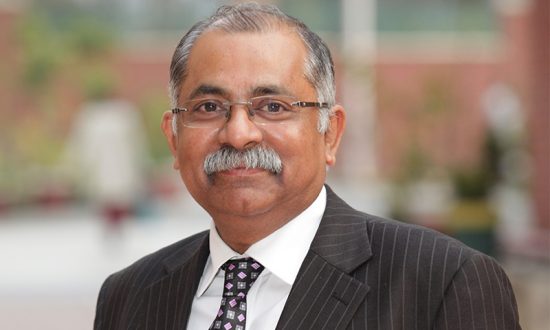Dr. Vijayan Immanuel is an academician with an in-depth knowledge and a profound skill set in research and education. With an experienced career spanning over 35 years, Dr. Immanuel is currently leading Vidyashilp University as Vice-Chancellor, academic leader and professor. Dr. Immanuel obtained his B.Tech in Electrical Engineering from the National Institute of Technology Karnataka, Surathkal (NITK). Dr. Immanuel holds a PhD in Electrical Engineering from the prestigious Indian Institute of Science (IISc), Bangalore where he played an integral role in the development and execution of campus and program expansions, PhDs and Post Doctoral research fellowships, leadership programs and teams among others.
The COVID-19 pandemic forced a sudden unprecedented global disruption of education, affecting literally every student and teacher globally. The response was equally unprecedented – as educational institutions and governments responded swiftly to adapt to ensure continuity of the education systems and safeguard the students and academic community. Educational institutions had to be shut down and remote/online teaching processes were rapidly migrated to digital platforms, in many instances within a week’s time.
Since March 2020, the global adaptation to remote teaching processes has certainly proved beyond any doubt – the resilience, agility and drive of the learners, teachers and administration to not only maintain the education processes and services, but to be counted on to the usher in a reformed education order. The reality is that this ‘pandemic forced experience’ will change education as never before. The National Education Policy(NEP) 2020 was announced in the thick of the pandemic – a clear conviction that education must reform, prevail over unforeseen challenges and fulfil the aspirations of the largest youth population in the world.
These thoughts are related to higher education in our context. After over 18 months, higher educational institutions are opening their campuses in carefully planned stages and batches. While the students are all agog, the excitement masks some uneasy questions: Is it back to normal? Is it graduation as usual, or, will it be a different pathway to complete the remainder of the academic Program? It is necessary for the higher education community to converge on solutions to two important and urgent issues as a result of the prolonged disruption and experimentation.
One, to quickly assess the “learning loss” (named as “the COVID slide”). For instance, consider the case of students who were newly admitted to the first-year undergraduate programs in 2020. Unfortunately, they could not experience the University Campus life and the collective learning experiences for about two academic years. These students experienced remote teaching-learning and assessments for almost half the duration of their academic program. Most of these students will be experiencing the University campus and in-person learning experience at the start of the 3rd year of the UG program! It is important to have practical insights and measures on the learning loss. The purpose should not be to maximize replacement learning. Conventional rescheduling of components of courses and related ‘substitution classes’ are not likely to yield the desired outcomes given the scale of the disruption and the time available for recovery.
Instead, the urgent need is collaborative research (using the expansive data points and diverse experiences) to obtain insights on specifics of lost learning that need to be prioritized. The objective should be to design reinforcement learning to ensure that adequate foundations are in place for future learning. A structured intervention and remediation will enable students to progress well through the remainder of the program curriculum and achieve a revised set of program outcomes.
The second issue has to do with our experiences from the ubiquitous “Online Classrooms”. Online education was the option available to students and faculty during the lockdowns. A variety of digital technology platforms supported students and faculty in weathering the pandemic crisis. It is quite well established that effective online learning results from systematic instructional design and development. However, most Universities did not have this competence and adequate learning resources. Faculty used digital platforms to conduct classes using “ppts”. Many Institutions were compelled to select full courses and online content from a plethora of platforms to either substitute few courses in the concerned curriculum or to augment learning within the regular course through asynchronous modes to give students the flexibility of time and pace. While this certainly helped to ride the tide and maintain continuity of the learning processes, the ineffectiveness was certainly exposed. Such ready-made online content/courses were not designed, even intended to be in alignment with the concerned program curricular objectives and relevant pedagogical processes to ensure experiential learning.
At the onset of the pandemic, Professors Vijay Govindarajan and Anup Srivastava proactively posed three questions(albeit in the American context) in their article published in HBR. A couple of these questions are very relevant for us as we reflect and think ahead: ‘What improvements are required in IT infrastructure to make it more suitable for online education? What training efforts are required for faculty and students to facilitate changes in mindsets and behaviors?’
University leaders must extract value from the huge data of the remote learning-teaching experience and build sustainable solutions for these questions. Research must be done, with focussed pilot projects to ensure that we are asking the right questions, identifying key challenges that need to be addressed to build future education models. Going forward this should be an area of development and made as a regular practice and capability in the University’s learning support systems.
Without any doubt the designers of the post-pandemic education processes are the faculty and students who have experienced this disruption. Data Science and Learning Analytics are crucial to decision making to enable our faculty and students to create new learning systems that will emerge as the new normal!




